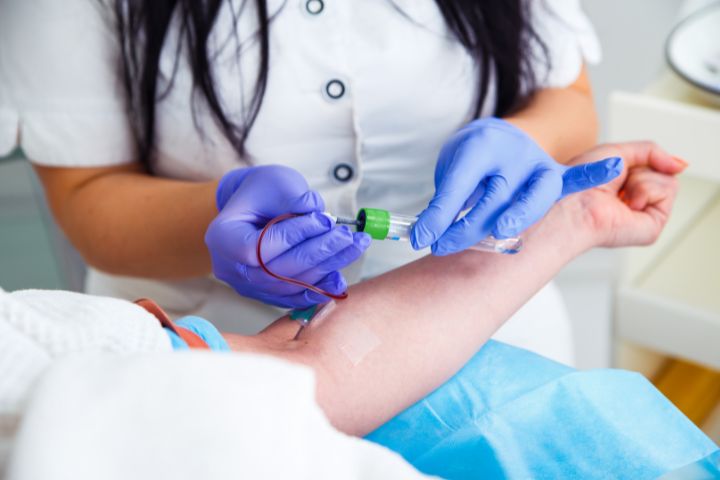The Ultimate Guide To Northeast Medical Institute - New Haven Campus Phlebotomy Course & Cna Class
The Ultimate Guide To Northeast Medical Institute - New Haven Campus Phlebotomy Course & Cna Class
Blog Article
The Main Principles Of Northeast Medical Institute - New Haven Campus Phlebotomy Course & Cna Class
Table of ContentsThe Buzz on Northeast Medical Institute - New Haven Campus Phlebotomy Course & Cna ClassThe Best Strategy To Use For Northeast Medical Institute - New Haven Campus Phlebotomy Course & Cna ClassNortheast Medical Institute - New Haven Campus Phlebotomy Course & Cna Class Fundamentals ExplainedThings about Northeast Medical Institute - New Haven Campus Phlebotomy Course & Cna ClassThe 6-Second Trick For Northeast Medical Institute - New Haven Campus Phlebotomy Course & Cna ClassA Biased View of Northeast Medical Institute - New Haven Campus Phlebotomy Course & Cna Class
The use of such gadgets should be accompanied by various other infection prevention and control techniques, and training in their usage. Not all safety devices apply to phlebotomy. Prior to selecting a safety-engineered device, customers need to completely examine readily available gadgets to identify their suitable usage, compatibility with existing phlebotomy practices, and efficacy in protecting personnel and patients (12, 33).For settings with reduced sources, expense is a motoring variable in purchase of safety-engineered tools. Where safety-engineered devices are not offered, proficient usage of a needle and syringe is appropriate.
One of the crucial markers of high quality of treatment in phlebotomy is the participation and participation of the patient; this is mutually beneficial to both the wellness employee and the patient. Clear information either composed or spoken must be offered to every client who undergoes phlebotomy. Annex F supplies example text for clarifying the blood-sampling procedure to a client. labelling); transport problems; analysis of results for medical monitoring. In an outpatient department or center, supply a specialized phlebotomy work area containing: a tidy surface with 2 chairs (one for the phlebotomist and the other for the patient); a hand wash container with soap, running water and paper towels; alcohol hand rub. In the blood-sampling area for an outpatient department or clinic, offer a comfy reclining sofa with an arm remainder.
The Main Principles Of Northeast Medical Institute - New Haven Campus Phlebotomy Course & Cna Class
Guarantee that the signs for blood tasting are plainly defined, either in a created protocol or in documented directions (e.g. in a laboratory type). Whatsoever times, adhere to the techniques for infection avoidance and control noted in Table 2.2. Infection avoidance and control practices. Gather all the tools needed for the procedure and location it within secure and easy reach on a tray or trolley, ensuring that all the things are plainly visible.
Introduce yourself to the client, and ask the individual to specify their complete name. Inspect that the lab type matches the client's identification (i.e. match the person's details with the research laboratory form, to make sure precise recognition).
Make the patient comfy in a supine position (if possible). The patient has a right to reject a test at any time prior to the blood sampling, so it is crucial to guarantee that the person has recognized the treatment - PCT Courses.
The Single Strategy To Use For Northeast Medical Institute - New Haven Campus Phlebotomy Course & Cna Class
Expand the client's arm and check the antecubital fossa or forearm. Situate a blood vessel of a great size that shows up, straight and clear. The layout in Area 2.3, shows common settings of the vessels, but numerous variants are feasible. The median cubital capillary lies in between muscles and is usually one of the most simple to puncture.
DO NOT insert the needle where capillaries are drawing away, since this increases the possibility of a haematoma. Finding the vein will certainly assist in identifying the appropriate dimension of needle.
Haemolysis, contamination and presence of intravenous liquid and medicine can all alter the results (39. Nursing team and medical professionals may access central venous lines for specimens complying with protocols. However, samplings from central lines lug a risk of contamination or erroneous research laboratory examination outcomes (https://www.reverbnation.com/artist/marvingordon). It serves, however not ideal, to draw blood samplings when initial presenting an in-dwelling venous device, prior to attaching the cannula to the intravenous liquids.
Some Known Details About Northeast Medical Institute - New Haven Campus Phlebotomy Course & Cna Class
Failing to enable sufficient call time boosts the threat of contamination. DO NOT touch the cleaned up website; in certain, DO NOT position a finger over the vein to direct the shaft of the subjected needle.
Ask the person to form a hand so the blood vessels are a lot more popular. Go into the vein promptly at a 30 level angle or less, and proceed to present the needle along the blood vessel at the simplest angle of entrance - Phlebotomy Courses. When enough blood has actually been accumulated, launch the tourniquet BEFORE taking out the needle
Northeast Medical Institute - New Haven Campus Phlebotomy Course & Cna Class for Dummies
Withdraw the needle carefully and use gentle pressure to the website with a clean gauze or completely dry cotton-wool sphere. Ask the patient to hold the gauze or cotton wool in area, with the arm prolonged and elevated. Ask the patient NOT to flex the arm, since doing so triggers a haematoma.

All about Northeast Medical Institute - New Haven Campus Phlebotomy Course & Cna Class
Do not push the syringe plunger due to the fact that additional stress boosts the risk of haemolysis. Where possible, keep the tubes in a rack and move the shelf in the direction of you. Inject downwards into the suitable coloured stopper. DO NOT remove the stopper because it will see this site certainly release the vacuum. If the sample tube does not have a rubber stopper, infuse very gradually into television as lessening the stress and speed utilized to move the specimen minimizes the risk of haemolysis.

Report this page